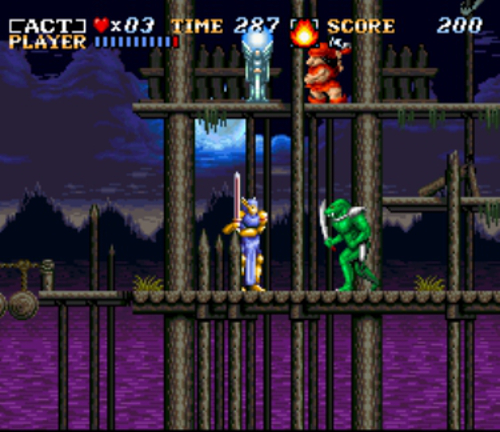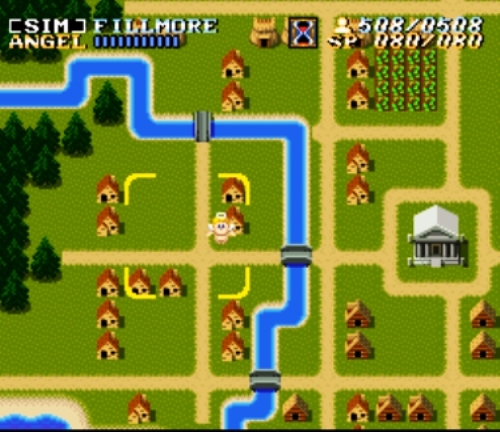man, Jamie, you're killing it with the reviews! I got to get my ass in gear!
ActRaiser Review Rewind
|
|
See PixlBit's Review Policies

On 10/06/2015 at 12:00 AM by Jamie Alston Playing God never felt this ethical. |

If you like your side-scrolling platformers mixed with a builder-sim\RPG and a superb orchestral soundtrack, you will really enjoy this one.
By the time the Super Nintendo was introduced, games that combined multiple genres were nothing new. Games like The Legend of Zelda, Crystalis, and The Guardian Legend were outstanding pioneers of the action/adventure variety. But developer Quintet partnered with Enix to publish ActRaiser in 1991 on the Super NES. Released just 3 months after the new home console, it was one of the earliest post-launch SNES games. Particularly outstanding is that it combines side-scrolling action with building simulation gameplay elements. Usually, building simulations send me running for the hills because I'm terrible at them. But after spending a little time with the game, I was able to put my fears aside.
You play the role of "The Master”-- supreme ruler and peace-keeper of the world. His evil nemesis Tanzra lives only to create chaos and destruction and therefore opposes The Master. Long story short, Tanzra and his guardians divide the world into six lands, and spread terror everywhere. It's up to The Master to restore order and peace and destroy Tanzra.

The design behind ActRaiser was certainly an ambitious one to say the least. The game is comprised of six civilizations. Each area has two action/platforming sections called "Acts" (hence the name of the game) and a simulation mode nestled in-between the action stages. Your goal is to rid the general area of the initial group of monsters in Act 1, help the civilization's inhabitants rebuild their society in Simulation Mode, and finally rid the area of its true source of malice in Act 2. The end result basically being that everyone loves you and can fend for themselves without your direct involvement.
From a gameplay standpoint, the action stages are pretty standard hack-and-slash fair-- you run around jumping on platforms, destroying enemies with your sword, and collecting items (extra points, health, or a 1Up). Overall, the action stages are fairly easy to get through. I found the most difficult parts to be the boss battles in Act 2 of each area. The good news is that most of the bosses either have super exploitable attack patterns or weaknesses against special attacks that can be used from "offerings" obtained from the people you oversee in Sim mode. You just need to remember to equip it before going into battle.
Simulation mode is where you'll be spending most of your time in the game as it plays a major role in your overall advancement. Here, the game also features a few RPG components in the form of leveling up your character's stats and using "spirit points" (SP) to perform miracles. There’s also story elements that are slowly revealed through the humans you oversee. The key to raising your level stats and advancing further into the game is increasing the population of the current civilization(s) you're overseeing at the moment. In order to do that, you'll need to direct them in building houses, growing crops, and see to their overall wellbeing. Part of doing this will require the use of your miracles to produce rain, destroy obstacles, uncover hidden areas, etc.

When I first got to the simulation section of the game I was expecting a more complicated, unfriendly experience. But I was delightfully surprised that navigating menus and performing commands in this mode were rather enjoyable. If you want to build up your town or affect change through use of your miracles, you simply select the command from the menu and guide the cursor in the direct spot that you want changed. The simplistic streamlined features make the game's simulation mode very approachable for players that don't like being bogged down with too many details and options common to other sim-centric games such as Sim City and the like.
Additionally, you'll notice that you yourself are not present in the simulation mode. Instead, your assistant cherub is tasked with destroying the creatures that threaten your people. Some enemies will pick up humans and carry them off. Others will destroy crops or cause earthquakes-- all of which will cause the population drop. The cherub can fire arrows at the enemies and also be used to pin-point where your miracles will be used. There are several monster lairs throughout the land that continually re-spawn enemies soon after you've killed one of them. The simulation sections are considered to be "complete" once the people are able to seal off all the monster lairs by building overtop of them.

As you progress to further into the game, certain problems will occur that require you to revisit places you've already built up. For instance, after completing Act 2 of Kasandora, the people will begin to suffer from the plague. A bit later in the game, you'll gain a healing herb from people of Marahna to take back to Kasandora. The moments like this are intertwined throughout most of the game. I rather enjoyed that aspect of the sim mode. It gave the different civilizations a feeling of interdependency instead of merely being new places to visit and forget afterwards.
The game's graphics are quite impressive for an early Super Nintendo game. Before the start of each Act, you're treated to an overhead viewpoint that spirals downward, ever closer to ground. It conveys the idea that the hero is dramatically hurling down to the battle grounds. But where the visual presentation especially shines is in the sharp colors and vivid, detailed backgrounds in the action stages. I especially enjoyed the pyramid stage in Kasandora. As you get deeper into the structure, you'll notice these golden statues and buildings that can be seen far into the background.
The bosses in each area tend to be huge, well-defined adversaries. Defeating such colossal enemies adds to that epic feeling that persist throughout the game. My only gripe is that your character's mobility feels somewhat stiff, especially when you need to hit an enemy multiple times in rapid succession or perform a jump attack to hit something in midair.

Equally remarkable as the visual presentation is the musical score. It was composed by Yuzo Koshiro-- best known for his superb scores for Revenge of Shinobi and the Streets of Rage series. His stamp of quality audio goodness is present all over this game. The compositions feature realistic orchestral tunes that kept me interested in finishing each stage. Some of my favorites include the music for Filmore (Act 1 especially), Northwall, and the simulation sections. I found the audio to be engaging and replete with nice subtleties that were rarely heard in games back then.
ActRaiser is that rare gem that can please fans of platformers, building simulations, RPG's or any combination of the three genres. The game is a masterpiece from start to finish thanks to the well-balanced game design, easy-to-grasp simulation portions, and music compositions worthy of a Star Wars movie. This game was a excellent example of what the Super NES was capable of producing and would make a fine addition to any collection.










Comments